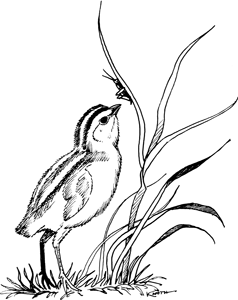Typically, quail have two daily feeding periods: one beginning at daylight and continuing for several hours, the second beginning during mid-afternoon and continuing until roosting. Abundance and food item size influence the length of feeding periods. Adverse weather alters both the length and timing of feeding periods, as will disturbances, particularly those serious enough to cause the birds to flush. Birds that have been flushed may miss a meal entirely.
Quail take practically all their food from or within eight inches of the ground’s surface. Bobwhites are not strong scratchers and are incapable of reaching food that is buried in the soil or a heavy accumulation of litter.
Fortunately the list of food items taken by quail is extremely long. Various studies of fall and winter bobwhite food habits show seeds of native or naturalized forbs are those most frequently consumed. Of the various plant classes, the seeds of legumes are eaten in the largest amounts and greatest variety. A partial list of the more important naturally occurring plants that produce seeds consumed by bobwhites is shown below. There are many others.
| Naturally Occurring Plants Important to Quail for Food | ||
|---|---|---|
| Common name | Scientific name | Legumes (L) |
| Annual lespedezas: Korean lespedeza Common lespedeza (variety, Kobe) |
Lespedeza stipulacea Lespedeza striata |
(L) (L) |
| Beggarweeds or tick trefoils |
Desmodium spp. | (L) |
| Ragweeds | Ambrosia spp. | |
| Partridge peas | Cassia spp. | (L) |
| Bush clovers | Lespedeza spp. | (L) |
| Oaks | Quercus spp. | |
| Pines | Pinus spp. | |
| Sweet gum | Liquidambar styraciflua | |
| Dogwoods | Cornus spp. | |
| Honeysuckle | Lonicera japonica | |
| Panic grasses | Panicum spp. | |
| Crab grass | Digitaria spp. | |
| Source: Bobwhite Quail Food Habits, Tall Timbers misc. publication #4, by Landers and Johnson |
||

Though not often reported from past food habit studies, pokeweed seed frequently appears in the crops of quail using clearcuts. Greens are an important spring and summer food, and a supplement during fall and winter. Soft fruits, as they ripen, are seasonally important, as are agronomic grains left standing or spilled during harvest. Though to a lesser degree than chicks, juvenile and adult quail frequently include insects in their diet. Insects make up about 15% of a quail’s total annual food consumption.
Feeding cover
For fall and winter feeding, idle lands in the fallow stage (brood range revisited) are among the best, having the ground and cover conditions needed, and usually, an array of seed producing annual forbs. Old fields also provide suitable feeding areas if there is not too much litter. Food items found in old fields include perennial forbs and fruit bearing woody plants. Some of the more utilized grass seeds, those of panic, crab and foxtail grasses also will be present in old fields. The mast of pioneer tree species, including dogwood and sassafras, provide another source of food in old fields and fencerows. The seeds of mature pines, sweet gum and oaks are important food items occurring in woodland. Sweet gum produces a small, winged seed that is released from its spiny “gum ball.” Seed of the oaks, when taken by quail, are typically acorn fragments left by other animals or crushed by vehicles.
Harvested grain fields are frequently used for feeding. The greatest use of these occurs where enough stubble remains to provide some protection while gleaning. Quail occasionally venture into open cropland to feed, such as a closely cropped bean field or newly planted small grain, but nearby protective cover is a must.

